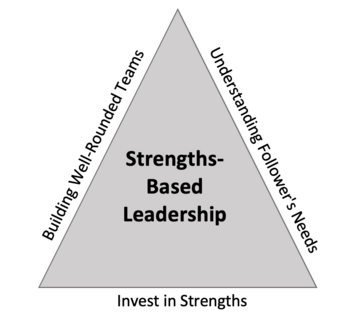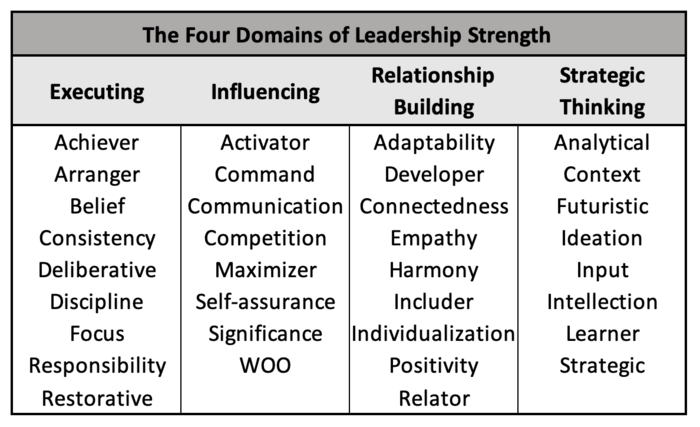Strengths-Based Leadership
Contents |
Abstract
Understanding the Strengths-Based Leadership Model
The organizational and leadership community's "strengths movement" began years ago, with Peter Drucker and Donald Clifton serving as its forerunners in 1967 and the 1990s, respectively. The idea that the best managers build on their team members' strengths rather than attempting to address their weaknesses was later developed by Marcus Buckingham and Curt Coffman. Later, Buckingham and Clifton asserted that individual talents are enduring and distinctive and that the greatest room for personal growth was in the areas of strengths. These claims led to the disproving of two popular myths at the time regarding training programs, namely that (1) anyone can become proficient at anything with enough effort, and (2) areas of personal weakness offers the most potential for development. They later developed the Clifton StrengthsFinder, a tool that enables people to identify their strengths and play to them. This leadership theory was later formalized by Tom Rath and Barry Conchie under the name strengths-based leadership.
A strength is the ability to consistently display near-perfect performance in a specific activity. The aim of leadership that puts an emphasis on strengths is to increase an organization's effectiveness, productivity, and achievement by highlighting and continuously enhancing the strengths of its individuals. Strengths-based organizations put more of an emphasis on developing talents and minimizing the negative effects of weaknesses than ignoring them. Leaders who put an emphasis on strengths make investments in both their own and their team members' strengths. [1] Rath and Conchie's strengths-based leadership theory identifies three principles of effective leadership. The principles area as follows
- The most effective leaders consistently invest in strengths
- The most effective leaders maximize their team by surrounding themselves with the right individuals
- The most effective leaders have understanding of the needs of their followers

Investing in strengths
First, instead of attempting to be excellent in every area, effective leadership requires focusing on strengths. Many organizations seek out leaders who are skilled communicators, visionaries, and executors, but the truth is that no leader can be exceptional in all of these areas. Every leader has a different set of skills and limitations, so understanding the strengths is crucial to become an effective leader. Unfortunately, leaders frequently lack awareness of their own personalities, which causes issues. Furthermore, the fact that most people don't get to do what they do best every day makes them dissatisfied with their current jobs. The StrengthsFinder, developed by Clifton and his team as mentioned above, was created to help leaders identify their strengths in order to address this issue.
It can be challenging to develop self-confidence when one focuses on others' flaws because this can result in a loss of confidence. According to research, taking the StrengthsFinder assessment and learning more about one's strengths can boost one's confidence, which raises engagement and productivity in the workplace. Young people who develop self-awareness and confidence may have a cumulative advantage that lasts their entire lives. A study found that 26 years later, people who had the chance to use their strengths early on reported higher levels of job satisfaction and income.
A strengths-based approach can be established by leaders who are aware of their own strengths and help others discover their own, which can increase engagement, productivity, and overall success within organizations, making it a worthwhile investment.
Building well-rounded teams
Second, the most effective leaders are those who surround themselves with the right people and take advantage of their individual strengths. But more often than not, leadership teams are the result of circumstance rather than design. This has the effect of causing new team members to be hired without taking into account the strengths of the team's existing members. Even when leaders recruit for strength, they unintentionally tent to gravitate toward individuals who act, think or behave like themselves. Executing, influencing}, relationship building, and strategic thinking are four separate strength-based leadership domains that Tom Rath and Barry Conchie presented. It is suggested that thinking about how leaders might contribute to a team may be helpful when considering these broad types of abilities. In contrast to having one dominant leader who attempts to take on everything or individuals who all have similar strengths, their research finds that a team must have a representation of strengths in each of these four categories. Teams should be well-rounded even when individuals are not required to be. Based on a statistical factor analysis and a clinical assessment by Gallup's leading scientists, the 34 themes that make up the StrengthsFinder naturally cluster into these four categories of leadership strength.
In short, leaders that excel at executing know how to take an idea and make it a reality. Influential leaders may take command, sell ideas, and ensure that the team is heard. Relationship building leaders hold the team together and enables it to become stronger than the sum of its parts. Lastly, strategic thinking leaders keep the team's attention on the future while continuously gathering data and improving decision making.

Indicators of high-performing teams
Once the proper individuals have been gathered, determining if the team is moving in the right direction becomes a very rather simple task. A strong and high-performing team can be recognized by certain indicators, according to Gallup's almost four decades of study on leadership teams. These indications include the following: (1) conflict doesn't break strong teams down because they are results-oriented, (2) strong teams prioritize what's best for the organization before moving forward, (3) members of strong teams are equally committed to their personal lives and work, (4) strong teams embrace diversity, and (5) strong teams are magnets for talent.
Understanding follower's needs
Third, the most successful leaders are those who are capable of inspiring a wide range of individuals to support the missions and vision of an organization. Moreover, a leader's key traits is their ability to motivate and coordinate the efforts of others to accomplish a desired outcome. Gallup conducted a systematic survey to gather thoughts on leadership from the general public between 2005 and 2008 in order to better understand this. Over 10,000 followers were contacted by The Gallup Poll for the study. According to the study's findings, it was evident what followers required and wanted from prominent leaders in their lives. Follower's four basic needs are as follows: Trust, compassion, stability and hope [2].
Application
Key Considerations
Strengths-based leaders recognize the importance of discovering, developing and leveraging their own and their followers' strengths, which improves organizational effectiveness and task performance. When establishing strengths-based leadership, the following suggestions that have been derived from its theory - discussed above - should be noted.
Identifying the leader's strengths
Strength-based leaders should begin with gaining profound understanding of their own distinctive strengths. [3] This may be accomplished through tests such as the StrengthsFinder assessment - now often referred to as StrengthsFinder 2.0 - which evaluates behavioral patterns to identify talent-dominant themes. Additionally, examining a individual's impulsive behaviors, desires, or areas of rapid learning can also identify their strengths.
Understanding the team's strengths
Once an understanding of the leader's strengths have been acquired, assessment of each team member's strengths should be conducted. Here as well, the StrengthsFinder assessment may prove to be helpful. [1]
Assign tasks, according to strengths
Tasks can be delegated in a way that optimizes each individual's skills and performance after the aforementioned steps have been completed. Team members are more engaged and driven to work successfully when assigned tasks that play to their strengths. As a result, the team and the organization as a whole perform better, are more productive, and are more satisfied at work. Strengths-based development should be encouraged going forward in light of these advantages. [3]
Promote a strengths-based culture
Organizations that seek to foster strength-based leadership must encourage a strengths-based culture. As a result, it's crucial to match the organization's performance management philosophy with the strengths-based culture. During performance evaluations, managers should support their team members' strengths and offer rewards and opportunities for growth that are consistent with their strengths. Employees will feel appreciated and respected if they are given clear performance standards and goals to work toward.
Moreover, leaders that use a strengths-based approach have the following main approaches for addressing employees' weaknesses: (1) altering a role to suit the individual rather than the other way around, (2) enabling staff to seek assistance from those with favorable strengths, and (3) reassigning a person if their core abilities are not a fit for the role's essential criteria.
Having managers that are intrinsically suited for the position can make a difference in bringing a strengths culture to life. These managers should be enthused by supporting others develop their strengths and have an interest in how different individuals function. Furthermore, having experienced strengths coach may be valuable for organizations. Human resources professionals who have a passion to coach and the coaching ability may become experts in strengths, coaching workers and ensuring they play to their strengths at work every day. The most effective managers assemble teams with a strategic purpose, based on personal and team preferences, rather than hastily assemble the teams. [4]
Annotated Bibliography
Gallup, Rath, T., & Conchie, B. (2008). Strengths Based Leadership: Great Leaders, Teams, and Why People Follow. Simon and Schuster.
The strengths-based leadership approach, which places a strong emphasis on acknowledging and using team and individual strengths to improve organizational performance, is thoroughly explained in this book. The authors explore the key components of strengths-based leadership, such as the significance of focusing on individual's strengths, creating an encouraging work environment, and establishing strong relationships with team members, by drawing on extensive research by Gallup and real-world experience. Along with strategies for implementing these newfound insights to use to increase leadership effectiveness, the book also includes a thorough assessment tool, the StrengthsFinder, for identifying personal and team strengths. For those looking to understand and incorporate strengths-based leadership principles into their own leadership practices, this book is a must-read.
Pearce, R. (2018). Be a Project Motivator: Unlock the Secrets of Strengths-Based Project Management (1st ed.). Berrett-Koehler Publishers.
Project managers are provided with guidelines for incorporating strengths-based approaches and positive psychology into their projects in this book by R. Pearce. The book demonstrates how team strengths can be identified and used to increase productivity and the likelihood of project success through the use of practical examples. The author highlights the importance of being a project motivator and offers practical strategies for fully making use of team strengths. The book also offers suggestions for avoiding common pitfalls as well as insightful information about potential difficulties that might arise when strengths are prioritized. In general, this book is an invaluable tool for project managers who want to foster an encouraging and productive workplace environment.
References
Citation
- ↑ 1.0 1.1 1.2 Burkus, D. (2011). Building the Strong Organization: Exploring the Role of Organizational Design in Strengths-Based Leadership. Journal of Strategic Leadership, 3(1). ISSN 1941-4668.
- ↑ 2.0 2.1 Gallup, Rath, T., & Conchie, B. (2008). Strengths Based Leadership: Great Leaders, Teams, and Why People Follow. Simon and Schuster.
- ↑ 3.0 3.1 Ding, H., Yu, E., & Li, Y. (2020). Strengths-based leadership and its impact on task performance: A preliminary study. South African Journal of Business Management, 51(1). https://doi.org/10.4102/sajbm.v51i1.1832
- ↑ Flade, P., Asplund, J., & Elliot, G. (2015, October 8). Employees Who Use Their Strengths Outperform Those Who Don't. Gallup.